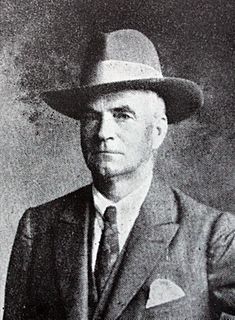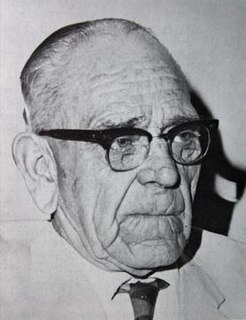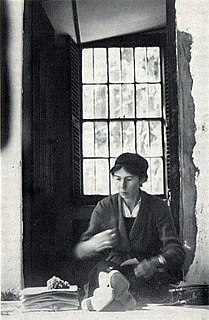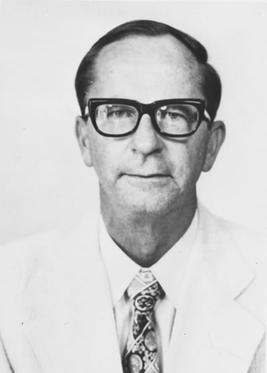
Glossopteris [etymology: from Ancient Greek γλῶσσα + πτερίς ] is the largest and best-known genus of the extinct Permian order of seed ferns known as Glossopteridales. The genus Glossopteris refers only to leaves, within a framework of form genera used in paleobotany. Species of Glossopteris were the dominant trees of the middle- to high-latitude lowland vegetation across the supercontinent Gondwana during the Permian Period. Glossopteris fossils were critical in recognizing former connections between the various fragments of Gondwana: South America, Africa, India, Australia, New Zealand, and Antarctica.

Ganapathi Thanikaimoni, often referred to as Thanikaimoni was an Indian palynologist.

Birbal Sahni FRS was an Indian paleobotanist who studied the fossils of the Indian subcontinent. He also took an interest in geology and archaeology. He founded what is now the Birbal Sahni Institute of Palaeobotany at Lucknow in 1946. His major contributions were in the study of the fossil plants of India and in plant evolution. He was also involved in the establishment of Indian science education and served as the President of the National Academy of Sciences, India and as an Honorary President of the International Botanical Congress, Stockholm.
Paul Bigelow Sears was an American ecologist and writer. He was born in Bucyrus, Ohio. Sears attended Ohio Wesleyan University, the University of Nebraska at Lincoln, and the University of Chicago.

Thomas Robertson Sim was a botanist, bryologist, botanical artist and Conservator of Forests in Natal, best known for his monumental work The Forests and Forest Flora of the Colony of the Cape of Good Hope which appeared in 1907. He was the eldest of five children of John Sim (1824-1901), a noted bryologist and Isabella Thomson Robertson (1823-).

John Hewitt was a South African zoologist and archaeologist of British origin. He was born in Dronfield, Derbyshire, England, and died in Grahamstown, South Africa. He was the author of several herpetological papers which described new species. He also described new species of spiders and other arachnids.

John Muir was a medical doctor, naturalist and cultural historian.

Gilbert Westacott Reynolds, was a South African optometrist and authority on the genus Aloe.

Margaret Rutherford Bryan Levyns was an eminent South African phytogeographer, botanist and taxonomist.
Abraham Erasmus van Wyk, also known as Braam van Wyk is a South African plant taxonomist. He has been responsible for the training of a significant percentage of the active plant taxonomists in South Africa and has also produced the first electronic application (app) for the identification of trees in southern Africa.

Edwin Percy Phillips was a South African botanist and taxonomist, noted for his monumental work The Genera of South African Flowering Plants first published in 1926.
Elsa Pooley, is a South African botanist, landscaper, tour guide, and artist.

Edna Pauline Plumstead was a South African palaeobotanist, of the Bernard Price Institute for Palaeontological Research, University of the Witwatersrand, Johannesburg, where she graduated in 1924. Edna lived in Cape Town the first seven years of her life and that is where she would explore and find wild flowers in the Cape Peninsula. Plumstead would later on connect the wild flowers to the same one in places like Australia and South America when she would later on defend the continental drift. She first began defending the theory of continental drift in the 1950s and has been described as one 'of South Africa's foremost scientists in the field of Gondwana paleobotany and geology'. Plumstead was awarded the Chrestian Mica Gondwanaland Medal by the Geological Society of India, and was made a Fellow of the Royal Society of South Africa.

Eduard Meine van Zinderen Bakker was a Dutch-born South African palynologist who made significant contributions to the fields of plant ecology, palynology and palaeo-ecology of Africa.

Genisteae is a tribe of trees, shrubs and herbaceous plants in the subfamily Faboideae of the family Fabaceae. It includes a number of well-known plants including broom, lupine (lupin), gorse and laburnum.
Chellapilla Venkata Rao (1910–1971) was an Indian botanist.

Johanna Alida Coetzee was a researcher in the field of Palynology at the University of the Free State and a pioneer in the analysis of fossil pollen. Her DSc thesis received worldwide recognition and praise from the eminent glacial geologist Richard Foster Flint and helped recognise the significance of temperature changes in controlling shifts in global and local vegetation zones.
Lucy Katherine (Kathleen) Armitage Chippindall, also known as Chipps and later as Mrs. Albert Oliff Crook was a South African botanist and agrostologist.

Marguerite Gertrud Anna Henrici was a Swiss-born South African plant physiologist. She is the author of over 80 scientific papers on food value of South African grasses and veld types. She was a member of the South African Association for the Advancement of Science, the South African Biological Society, and an honorary member of the South African Association of Botanist. She is commemorated in the genus names Neohenricia L. Bolus and Salsola henriciae Verd.

Don Foreman was an Australian botanist who worked on the Monimiaceae and Proteaceae of Australia. He also helped with the editing of selected Flora of Victoria and Flora of Australia Volumes.















